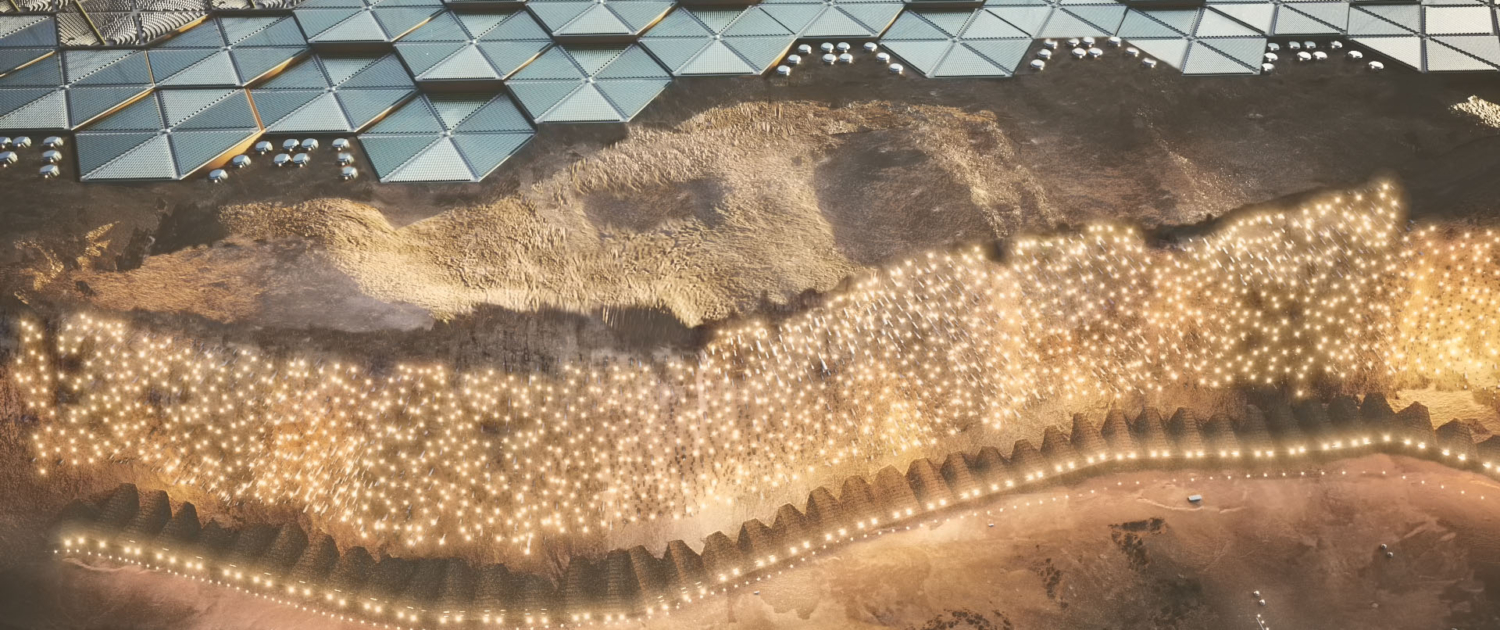Nüwa Martian City
Nüwa is a self-sufficient, excavated, vertical city at the cliffs of Tempe Mensa, on Mars. The design and construction systems at Nüwa are a result of the planet’s harsh conditions. The excavated solution protect inhabitants from the radiation, ensure indirect access to sunlight, protect from potential impact from meteorites, and efficiently solve the atmospheric pressure difference and temperature variations between the inside and the outside of the buildings.
Nüwa is the capital of a proposed colony of one million people on Mars. The rest of the cities follow the same urban strategy, such as Abalos City, located in the North Pole to leverage the access to ice, or Marineris City, located in the most extensive canyon of the solar system. The solution is a flexible and scalable model that could be easily applicable in many other Martian locations.
The city comprises self-sustained “Macro-buildings” inside the rock of the cliff, each accomodating 4,440 people. These constructions, implemented after tunneling, are modular and include residential and work activities, linked together by a three-dimensional network of tunnels. The modules have a tubular shape of 10 meters in diameter and 60 meters long, with two floors. There are three different residential and three work modules, providing a highly flexible and scalable opportunity by recombining the modules as needed. By giving this standardization, the design ensures scalability and reduces complexity, costs, and construction schedules.
All modules include green areas, urban gardens, and spaces dedicated to arts. The urban gardens are small community parks with animals and bodies of water designed to provide physical well-being.
To create an emotional linkage with Earth, Nüwa comprises artificially created green spaces. They are named “Green-Domes,” and there are two types: those that allow human presence and act as parks, and those that include experimental vegetation in an environment with a purely Martian atmosphere.
The “Macro-buildings” on the cliff are connected by high-speed elevator systems, similar to skyscrapers on Earth. This infrastructure also connects the bottom of the cliff with the top and has intermediate stops at the “sky-lobbies” that connect the “Macro-buildings” with a separate elevating system.
The highest point of the cliff is the Mesa. This vast plain contains the infrastructure dedicated to manufacturing, food production, and energy generation. Crops would be grown in agricultural modules with a CO2-enriched environment, which will not be breathable for humans, and as a result, the operational tasks in these facilities will be automated. A hydroponic system increases the crops’ efficiency, as it requires less water and space than other methods based on above-ground crops. This sector also accommodates the production of algae, cellular-meat, and bacteria for waste processing.
At the foot of the cliff, large pavilions have been located for social interaction in the Valley. These pavilions have been designed with translucent skin to offer views of the landscapes of Mars. These domes are protected from external radiation by large overflying canopies. The material from the cliff’s excavation is dumped on top of such roofs, protecting from radiation. At the same time, this strategy ensures recyclability even at the large-scale.
In the Valley, there are also specific structures to house hospitals, schools and universities, sports and cultural activities, shopping areas, and train stations that communicate with the space shuttle. Farming areas for animals and insects have been located at the Valley, close to communal city areas, as they need a human-like atmosphere to live.
An artificial mountain created with additional material extracted from the excavations acts as a visual frame for the city. It contains auxiliary energy systems, storage, and parking for rovers and intra-city trucks.
Project Year
2020
Team Members
Multidisciplinary Team that created Nüwa: SONet
Architecture & Urban Design: ABIBOO Studio, Alfredo Munoz, Gonzalo Rojas, Engeland Apostol, Sebastián Rodríguez, Verónica Florido, Owen Hughes Pearce.
Project Coordination, Economic model & High-level concepts: Guillem Anglada-Escudé, Ph.D.; RyC fellow in Astrophysics; Institut for Space Science/ CSIC & Institut d’Estudis Espacials de Catalunya.
Co-coordination. Space, Earth-Mars transportation & Socio-economics: Miquel Sureda, Ph.D; Space Science and Technology Research Group, Universitat Politècnica de Catalunya & Institut d’Estudis Espacials de Catalunya.
Life Support, Biosystems & Human factors: Gisela Detrell, Ph.D; Institute for Space Systems, Universität Stuttgart.
Mars Materials & Location: Ignasi Casanova, Ph.D.; Prof. Civil and Environmental Engineering; Institute of Energy Technologies (INTE), Universitat Politècnica de Catalunya.
Manufacturing, Advanced Biosystems & Materials: David Cullen; Prof. of Astrobiology and Space Biotechnology; Space Group, University of Cranfield.
Energy & Sustainability: Miquel Banchs i Piqué; School of Civil Engineering & Surveying, University of Portsmouth.
Mining & Excavation systems: Philipp Hartlieb; Prof. in Excavation Engineering, Montan Universitaet Leoben.
Social Services & Life Support Systems: Laia Ribas, Ph.D; RyC fellow in Biology, Institut de Ciències del Mar/CSIC.
Mars Climate modeling & Environment: David de la Torre; Department of Physics, Universitat Politècnica de Catalunya.
Contributors: Jordi Miralda Escudé (ICREA Prof. in Astrophysics – Ground Transport, UB; Rafael Harillo Gomez-Pastrana (Lawyer, – Political Organization & Space law); Lluis Soler (Ph.D. in Chemistry – Chemical processes, UPC); Paula Betriu (Topographical analysis, – UPC); Uygar Atalay (Location, temperature & Radiation analysis, UPC); Pau Cardona (Earth-Mars Transportation, UPC); Oscar Macia (Earth-Mars Transportation, UPC); Eric Fimbinger (Resource Extraction & Conveyance, Montanuniversität Leoben); Stephanie Hensley (Art Strategy in Mars); Carlos Sierra (Electronic Engineering, ICE/CSIC); Elena Montero (Psychologist); Robert Myhill (Mars science – U. Bristol); Rory Beard (Artificial Intelligence).
Financial Sponsors: ABIBOO Studio; CSIC (Consejo Superior de Investigaciones Científicas); UPC (Universitat Politécnica de Catalunya); Cranfield University; University of Stuttgart; IEEC (Institut d’Estudis Espacials de Catalunya); Montan University Leoben; Institut de Ciencies del Mar; University of Portsmouth.
Credits
ABIBOO Studio / SONet (Gonzalo Rojas, Sebastian Rodriguez)
Further Information
Nüwa Martian City, Explained
A general summary of Nüwa
Architecture in Nüwa


